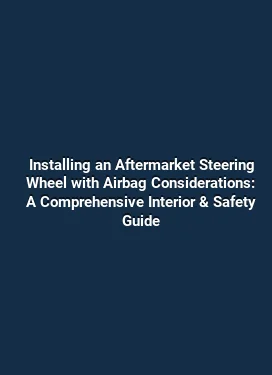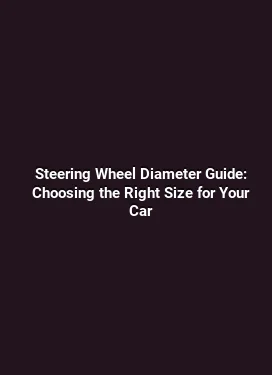Custom Gauge Cluster Installation: Digital vs Analog Options
The cockpit of a modern vehicle often serves as the primary interface between the driver and the machine. When choosing a gauge cluster upgrade, two broad paths emerge: digital clusters that replace traditional analog dials and enhanced analog clusters that preserve the classic needle-driven look. Each option brings distinct advantages in readability, functionality, and safety. Understanding the installation process, electrical demands, compatibility concerns, and long-term maintenance is essential for a reliable upgrade that preserves or enhances the driving experience.
Understanding the Core Differences Between Digital and Analog Clusters

Digital gauge clusters utilize high-resolution screens—often LCD or TFT panels—to display traditional gauges together with customizable digital readouts. They can integrate vehicle data from multiple CAN networks, provide graphing, and offer color-coded alerts. Analog clusters, by contrast, rely on mechanical needles and physical dials, delivering a familiar aesthetic with proven reliability. They typically consume less power and can be simpler to replace on classic cars that were originally designed around analog instrumentation.
From a readability standpoint, digital clusters excel in clarity under challenging lighting conditions and can scale readouts to suit the driver’s preferences. Analog clusters shine in instant, instinctive needle movement and straightforward interpretation for many drivers. For interior design, digital displays can be customized to match cabin ambiance with ambient lighting, while analog gauges retain a tactile, retro appeal that some owners value as part of a vehicle’s character.
Key Considerations Before Starting an Upgrade
Successful gauge cluster installation hinges on several practical and safety-oriented factors. First, assess vehicle compatibility. Modern cars with extensive CAN bus networks may require a digital cluster capable of parsing multiple data streams, while classic cars with few electronic features may benefit from plug-and-play analog upgrades. Consider the instrument cluster mounting geometry, bezel compatibility, and available space behind the dashboard. A secure and non-intrusive fit reduces vibration and misalignment risks that could impair readings or cause damage over time.
Power management is another critical factor. Digital clusters often demand a well-regulated 12V supply with stable ground reference, plus potential spikes during startup. Adequate fuse protection and proper wiring harness integration are essential to prevent voltage transients from affecting other systems. For analog upgrades, the primary concern is ensuring the replacement gauges align mechanically with the original shafts and that the odometer and trip meters continue to function or are properly replaced by certified components.
Digital Gauge Clusters: Features, Benefits, and Installation Nuances
Digital clusters provide a modern interface with multiple readouts, high contrast visibility, and the capacity to display custom dashboards. Features often include a digital speedometer, tachometer, fuel level, coolant temperature, oil pressure, voltage, and a suite of warning indicators. In some implementations, data can be pushed to mobile apps for diagnostics or telematics, enabling proactive maintenance planning and trend analysis. The ability to program color schemes and gauge shapes helps tailor the instrument panel to the driver’s preferences and the vehicle’s use case, from daily commuting to track days.
Installation typically involves replacing the stock instrument housing with a mounting frame designed for the digital module. Wiring requires access to key data lines such as speed signal, RPM signal, tachometer input, fuel level reference, and other sensor feeds. In CAN-based systems, a gateway or data adapter is often needed to translate vehicle signals into the digital cluster’s protocol. A careful approach includes labeling wires, testing power rails, and verifying sensor accuracy before final commissioning. For safety, ensure that critical readouts (speed, RPM, warning lights) remain legible and that the display doesn’t obscure essential indicators while driving.
Common installation phases include: removing the dash trim, disconnecting battery ground, mounting the digital housing, routing power and data wires, configuring the cluster’s orientation, calibrating needles if applicable, and performing a thorough system check. Many digital clusters offer automatic brightness adjustment, which helps maintain readability across day and night driving scenarios. Additionally, advanced digital units may provide digital trip meters, maintenance reminders, and fuel economy analytics that can guide efficient driving decisions.
Practical Tips for Digital Upgrades

- Verify that the chosen digital cluster supports the vehicle’s sensor set and speed signals. If not, you may need adapters or a custom calibration kit. Note: compatibility varies by model and year, so consult the product documentation or manufacturer support before purchasing.
- Plan the user interface by prioritizing essential readouts in the driver’s primary field of view. Critical data such as current speed, engine temperature, and oil pressure should be immediately readable without distraction.
- Ensure robust grounding and shielded data lines to minimize electrical noise that could impact sensor accuracy. A clean electrical environment reduces noise-induced flicker or erroneous readings.
- Protect the display from glare and heat exposure by selecting a mounting location with appropriate shading and ventilation. Digital panels can be sensitive to extreme temperatures, which may affect contrast and responsiveness over time.
Analog Gauges: The Case for Familiarity and Reliability
Analog gauge clusters bring traditional aesthetics and tactile feedback that many drivers associate with a sense of mechanical reliability. They tend to be straightforward to install on older vehicles and can be sourced as direct-fit replacements or through retrofitted assemblies that retain the stock look. For classic car enthusiasts, preserving the original instrument layout can maintain resale value and authenticity while still enabling reliability upgrades such as LED lighting for improved visibility.
When installing enhanced analog gauges, attention must be paid to dial calibration, needle alignment, and ensuring that the new instruments accurately reflect sensor data. In some cases, aftermarket analog units replace the entire cluster, combining a modern sensor array with analog readouts to deliver both vintage aesthetics and improved accuracy. Wiring typically follows the vehicle’s existing harness pattern, with careful matching of signal grounds and power supply rails to prevent interference with other dashboard electronics.
Connectivity in analog upgrades often centers on keeping the power, ground, and signal paths clean and organized. One practical approach is to use a dedicated distribution block for the gauge cluster’s power supply, along with shielded cables for critical feeds such as oil pressure and temperature sensors. This reduces the risk of cross-talk between gauges and improves long-term reliability in demanding driving environments.
Planning an Analog Upgrade: Key Steps
Begin by identifying whether you want a complete gauge replacement or a modular upgrade that preserves the existing bezel. Gather exact measurements for mounting holes, shaft alignment, and the instrument panel cavity depth. Check for compatibility with warning indicators and indicator lamps, ensuring that the new cluster can illuminate the same warning icons or provide equivalent functionality. After selecting gauges, create a wiring plan that maps sensor signals to the corresponding gauges and includes fusing, power routing, and ground distribution.
Calibration is a critical step for analog clusters. Some aftermarket gauges require calibration against known references, such as a controlled RPM range or a static fuel level test. A methodical calibration process ensures accuracy and prevents misreadings during real-world driving. Finally, perform a road test to verify readability at different speeds and lighting conditions, adjusting lamp brightness or dial contrast as needed.
Hybrid Solutions: Marrying Digital Readouts with Classic Interiors
In many scenarios, drivers opt for a hybrid approach that retains the vintage interior styling while incorporating select digital readouts. A common strategy is to replace only the primary tachometer or speedometer with a digital display, while keeping secondary gauges in analog form. This approach delivers the best of both worlds: modern data visualization for critical functions and familiar needle-based gauges for reference points. The blend should be seamless, with the digital module integrated into the instrument bezel and color-matched to the cabin’s aesthetic.
Hybrid installations require careful wiring to ensure that the digital module receives accurate signals without disruptively altering the analog gauges. It is essential to maintain a stable power supply and consider environmental protections, as both digital and analog components share the same dashboard environment. Drivers benefit from customizable dashboards where warning lights, fuel economy data, and maintenance reminders appear alongside traditional dials.
Safety Implications and Best Practices
Any instrument upgrade has safety implications. Clear, timely, and legible readouts are fundamental to safe driving. Ensure that the chosen cluster does not obstruct the driver’s field of view or create glare that could impair vision. Proper installation involves securing the cluster firmly to withstand vibration and impacts, using vibration-damping mounts if necessary. Wiring routes should avoid heat sources, moving parts, and potential contact with airbag systems or other critical components. For vehicles equipped with advanced driver-assistance systems, confirm that instrument updates do not interfere with sensor calibration or system diagnostics.
Testing is essential after installation. Begin with a bench test to verify power, ground integrity, and signal fidelity. Then perform a controlled on-road test at low speed to confirm that all gauges respond synchronously to engine and vehicle states. Finally, monitor readings over varied temperatures, road conditions, and humidity to ensure reliability across the typical operating envelope. Keeping spare fuses and a basic diagnostic toolkit in the glove compartment enables quick fault isolation should an issue arise.
Maintenance and Longevity Considerations
Digital clusters require firmware updates and occasional calibration checks, especially after software changes or electrical system work. Regularly inspect connectors for corrosion and ensure that seals remain intact to prevent moisture ingress. Analog gauges, while often robust, rely on sensor accuracy and mechanical integrity; periodic calibration and replacement of worn components help maintain precision. Regardless of the chosen route, use high-quality harnesses, protective sleeves, and properly rated wiring to extend the life of the cluster and related electronics.
Choosing the Right Path for Your Vehicle and Use Case
Ultimately, the decision between digital and analog clusters should align with the vehicle’s purpose, the owner’s preferences, and the desired maintenance profile. Daily drivers may benefit from the clarity and data-rich environment of digital clusters, along with maintenance reminders that help optimize scheduling. Classic cars or enthusiasts who value originality may prefer enhanced analog clusters or selective digital aids that preserve the interior’s vintage character while delivering improved reliability.
For performance-oriented applications, digital clusters can enable real-time telemetry, lap-style data views, and fuel efficiency metrics that inform driving strategies. On the other hand, in rugged or vintage contexts, analog clusters can deliver dependable operation with predictable behavior, even in challenging conditions where electronics may be more vulnerable to environmental factors.
Regardless of the path chosen, a well-planned installation, careful wiring, and adherence to safety guidelines are essential to maximize the benefits and minimize risks. By focusing on readability, reliability, and a cohesive cabin aesthetic, a gauge cluster upgrade can elevate both the functionality and the enjoyment of the driving experience.






